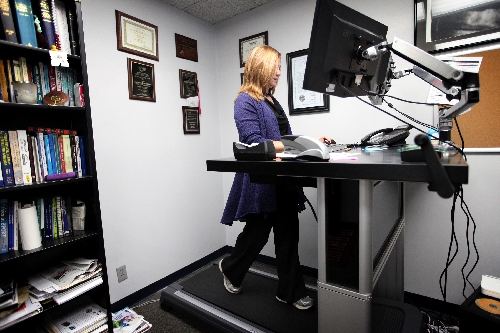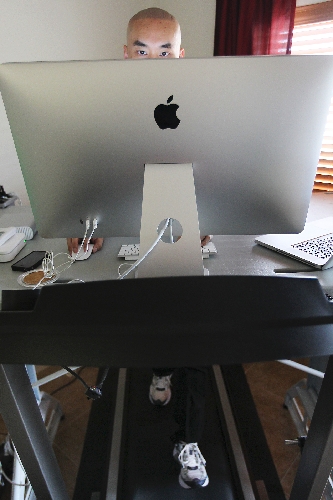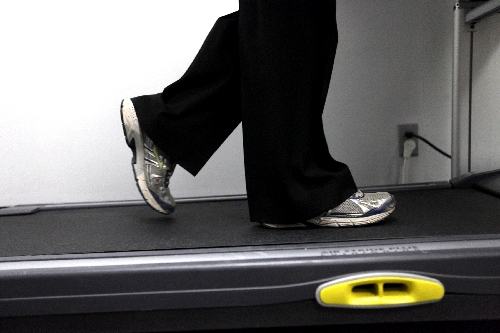Treadmill desks may help get office workers moving



Are you sitting down now? At your desk?
Maybe you shouldn’t be.
Sion Lee isn’t.
Lee, a 32-year-old graphic and Web designer in Las Vegas, has replaced his regular desk with a TrekDesk treadmill desk. Instead of sitting, he spends his days walking at about 2 mph, a pace that lets him talk on the phone without breathing hard and use his computer without falling off.
A growing body of research suggests that sitting for long periods, say an eight- or nine-hour workday, can contribute to health problems, even if you hit the gym before or after. For Lee, a treadmill desk is the right balance of work and play.
One observer sees merit in Lee’s motion.
"Sitting is bad for you, no doubt about it," said Ray Squires, program director for the Mayo Clinic’s cardiovascular health and rehabilitation center in Rochester, Minn. "The longer you are sedentary, the longer you sit, the greater your chances to develop cardiovascular disease, to die from any cause, to develop markers for diabetes."
DEATH BY SITTING?
Women who sit six hours a day during leisure time have a 40 percent higher rate of dying from all causes than do women who sit fewer than three hours, according to an American Cancer Society study reported in the American Journal of Epidemiology last year. For men in the same scenario, the sitters’ death rate was 20 percent higher.
Another study reported last year in the Australian journal Circulation found that each hour adults spend daily watching television — a famously sedentary pastime — increases their all-causes death risk by 11 percent, cancer death risk by 9 percent and cardiovascular disease-related death risk by 18 percent. The research concluded that besides promoting exercise, future chronic disease prevention strategies could focus on reducing sitting time.
Marc Hamilton of the Pennington Biomedical Research Center told The New York Times earlier this year that sitting people’s calorie-burning drops to about 1 calorie per minute and their bloodstream triglyceride levels plunge, causing a rise in LDL, or bad cholesterol.
Monica Lounsbery, professor and director of the physical activity policy research program in the University of Nevada, Las Vegas’ department of kinesiology and nutrition sciences, said sitting has increased markedly in recent decades in four big life phases: work, leisure, transportation and household. In essence, she said, we’ve engineered the activity out of our lives.
Even if people go to the gym and exercise vigorously for an hour three times a week, too much sitting may undo those benefits, she said.
Squires said treadmill deskwork isn’t meant as a substitute for the gym — you still need more intense activity to raise your heart rate and burn fat. But it can improve general fitness and reduce stress. Standing beats sitting, Lounsbery said, and walking is better still.
Carl Foster, director of the University of Wisconsin, La Crosse’s human performance laboratory, said the desks could help users burn perhaps 200 to 300 calories a day.
GROWING TREND
In the United States in 2010, 53.1 million people used treadmills and treadmill sales reached $1.1 billion, Mike May, spokesman of the Silver Spring, Md.-based Sporting Goods Manufacturers Association, said.
Steve Bordley, chief executive officer of Phoenix-based TrekDesk, doesn’t sell treadmills — he sells the desks, at about $480 delivered.
He said sales have tripled this year compared with last year. In 2010, he said, sales to Nevadans comprised 4 percent of sales, and this year sales in Nevada are up roughly 2 percent.
Grand Rapids, Mich.-based office furniture giant Steelcase has sold 3,000 of its Walkstation combination desk-treadmills, first introduced in 2007, said Maren Channer, the company’s marketing manager for Healthcare and Fit Work. She said the company is on pace to double last year’s sales of 1,000 machines. However, she said, Walkstations account for less than 1 percent of Steelcase’s overall office furniture sales.
While growing in popularity, treadmill desks are still mainly in home offices. Bordley said about 80 percent of TrekDesks sell to individuals.
Size may be an issue for many companies. A TrekDesk, for example, is 6 feet long and about 3 feet deep — hard to fit into tightly packed cube farm.
COST ONE FACTOR
Cost may be another deterrent. Lee, for example, said his TrekDesk and treadmill cost $1,000. A desk-treadmill combo sold by Fisher, Ind.-based TreadDesk sells for $2,500 to $2,700. Steelcase’s Walkstations sell for about $4,400.
Liability is another barrier.
Lou Landini, president of Las Vegas-based insurer Landini Associates Ltd., said treadmill desks could land a company in the same coverage class as athletic clubs and might send workers’ compensation premiums soaring.
"I’d really worry about the risk of injury," Landini said. "If you have an office setting, it’s clerical. Usually the biggest thing you have to lift might be a box. You might get a paper cut or carpal tunnel (syndrome).
"If your insurance company found out you’re adding these things, they’d certainly nix it," he added, "or they’d charge you so much you wouldn’t want to pay."
The Mayo Clinic’s Squires said businesses may want to balance the benefits of healthier workers against lower health insurance premiums, outweighing other costs.
"Corporations have figured out that improving wellness in general is cost-effective," Squires said. "It would be a surprise if in a few years we don’t have data show the cost advantages of this."
Lounsbery and a team of UNLV researchers are planning to do that study, and will look for employers interested in buying equipment, recruiting experimental and control-group participants and paying data collection costs.
Meanwhile, there are users like Lee, who said his TrekDesk has preventive benefits. Lee said a family member developed leg blood clots from Factor V Leiden, an inherited genetic disorder that can cause irregular clotting. He learned he might be susceptible and that the disorder worsens if you sit. So, he set out to find a way to avoid sitting while he operated his humor and art website, notalwaysright.com.
"I remembered hearing about this, so I started Googling around," he said.
Lee got his TrekDesk in November 2009 and said he uses it at least three hours a day. In the first week he had mild discomfort in his legs, ankles, calves, thighs and buttocks. His body was working out the kinks, he said.
"Initially the challenge was just trying to walk straight; it’s kind of easy to drift to the left or the right," he said. "But, after a week or so, you get used to it. Now I have no problem. I’m on it, but I don’t even know I’m walking."
Lee said he spends up to three hours at a time on his treadmill and feels better. He said he recommends the idea to his friends. Lounsbery, too, has an office treadmill desk. She said she uses hers, bought in December, for hours at a time, like Lee. And, like Lee, she reports feeling better.
"I hate sitting," she said.
Sally Edwards, a triathlete and owner of Sacramento, Calif.-based training and education company Heart Zones USA, liked the idea of the treadmill desk. People are likelier to move more often if they can find engaging ways to move, she said.
But, she added, only people who use the treadmill desks regularly will benefit.
"Fifty percent of garage sales have some kind of exercise equipment in them,” Edwards said. "You go to a few and you’ll see elliptical trainers and ski climbers and stationary bikes. I wonder whether we’ll see these after a while, too."
Gadget geekdom has usurped the cachet being active once had, Edwards said. And the treadmill desk may be just another gadget.
"I’m not sure if it wouldn’t be better not to just walk away from your desk and go out and get some fresh air and sunlight on your body, or grab a friend so you could engage with someone, and walk around the block and unplug from all the electronics," she said. "We’re so plugged in now, when are we ever free? This treadmill desk may be another way to not be free; you’d be tethered to the treadmill at your desk.
But, she said, "If people do it, it’s better than nothing."
Contact reporter Matthew Crowley at mcrowley@reviewjournal.com or 702-383-0304.
Employers interested in more information about participating in the University of Nevada, Las Vegas’ study on the effects of treadmill desks in the workplace, should write contact Monica Lounsbery, professor & director, physical activity policy research program, Department of Kinesiology and Nutrition Sciences, University of Nevada, Las Vegas, 4505 Maryland Parkway, Box 453034, Las Vegas, NV 89154-3034; 702-895-4629.











